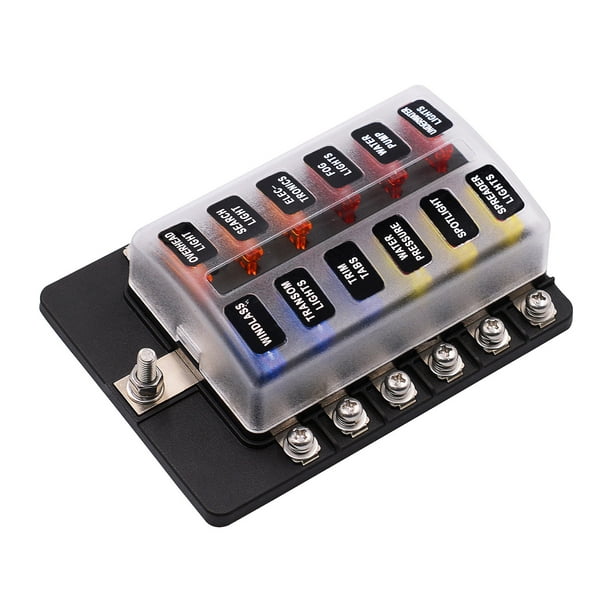Blue Sea Fuse Block for Dummies
Wiki Article
6 Easy Facts About Blue Sea Fuse Block Explained
Table of ContentsWhat Does Blue Sea Fuse Block Do?The 10-Second Trick For Blue Sea Fuse BlockHow Blue Sea Fuse Block can Save You Time, Stress, and Money.Excitement About Blue Sea Fuse BlockBlue Sea Fuse Block Fundamentals ExplainedOur Blue Sea Fuse Block Ideas
Fuses are bolted in position between the bus bar and also the second collection of electrically separated bolts. With this installment you can attach the watercraft's different high-current circuits, such as a windlass, bow thruster, high-output alternator, the DC panel, and so on, to the isolated bolts. The numerous integrates are sized according to the current-carrying ability of the conductors bolted to them.Some circuits will certainly still need to bypass the seclusion button so that they may be left on when the remainder of the boat is closed down. blue sea fuse block. These circuits usually consist of a bilge pump as well as any kind of charging gadgets (consisting of photovoltaic panels, perhaps a wind generator, and also the inverter if it also functions as a battery charger).
This is component of the circuit representation we developed for the complicated instance watercraft in our Boat Electrics program. The devices attached to the fuse block in the top right are all bypassing the isolation switch S1. If you authorize up for Boat Electrics 101, you will certainly find out how to check out such a layout as well as additionally how to make one for your own watercraft.
Excitement About Blue Sea Fuse Block

The objective is to supply defense at the source of power for every circuit. With DC circuits, the OCP is constantly positioned in the silver lining of DC circuits. (In addition to anything else, an unbroken link to DC adverse should be kept whatsoever times to shield against stray-current rust.) Keep in mind that some European boatbuilders mount integrates and also battery switches in the DC negative side as well as on the silver lining, however this is not suggested other than in some separated (drifting) ground DC systems.
This point might go to the battery, the battery button, the circulation panel, a subsidiary panel, some distribution bus bar, or various other linking point. If the conductors in the brand-new circuit are no smaller sized than the conductor that feeds the brand-new circuit's point of link, then the OCP for the feeder conductor will completely shield the brand-new circuit - blue sea fuse block.
Getting The Blue Sea Fuse Block To Work
Yet if the new circuit is not effectively offered by overcurrent devices already in position, added protection is needed at its factor of link, i. e., at its source of power. Placement of merges in the favorable conductor. Keep in mind how a smaller fuse is used each time a smaller sized conductor is attached, Often room restricts just how close an OCP gadget can be positioned check out here to the resource of power.If they should be set up in battery compartments, they must be ignition shielded.) The concern then develops, exactly how close is close sufficient? The generic response, from the ABYC, is within 7" (17. 5cm). The ABYC permits the following, which have actually been tightened up in the last few years: A conductor attached straight to a battery that is additionally "contained throughout its entire distance in a sheath or unit such as an avenue, joint box, control box or encased panel" need to have its overcurrent security "as close as achievable to the battery, however not to surpass 72 inches (1 - blue sea fuse block.
Gone is the blanket 72" allocation that utilized to be there. A conductor connected to a resource of power besides the battery (e. g., the battery switch, the circulation panel, or a few other factor in the DC circuits) that is similarly had in a sheath, etc, must have its overcurrent defense "as close as practicable to the point of connection to the source of power, yet not to surpass visit this page 40 inches (1.
10 Easy Facts About Blue Sea Fuse Block Described
Provided that alternators themselves are a source of power, it has been debatable whether these added alternators needed OCP at the generator itself."Cranking-motor circuits are not called for to have overcurrent protection.In the marine area, where cranking circuits might be long, this method may create a danger. It makes no sense to have any type of unprotected circuits on a watercraft.
In winter, the inrush existing on a 12V starter motor may be as high as 1,500 amps; the cranking current may be as much as 200 amps. Typically, cranking conductors are undersized even for the cranking current, not to mention the inrush existing. This scenario does not present a security issue per se, due to the fact that these currents are received for just a few secs, so the conductors do not have time to fume enough to create a fire threat.
How Blue Sea Fuse Block can Save You Time, Stress, and Money.
We made the program with absolute novices in mind. As the electric lots on boats boosts, so as well does the intricacy of electrical circuits as well as the capacity for brief circuits and electrical fires.
In the marine area, where cranking circuits may be long, this method could create a hazard. It makes no feeling to have any unguarded circuits on a watercraft.
Blue Sea Fuse Block Fundamentals Explained

If you wish to learn just how to wire a boat, step-by-step in 56 video clip lessons, have a look at our Boat Electrics 101 program. We made the training course with outright novices in mind. As the electric load on boats boosts, so also does the complexity of electrical circuits and also the capacity for short circuits as well as electric fires.
Report this wiki page